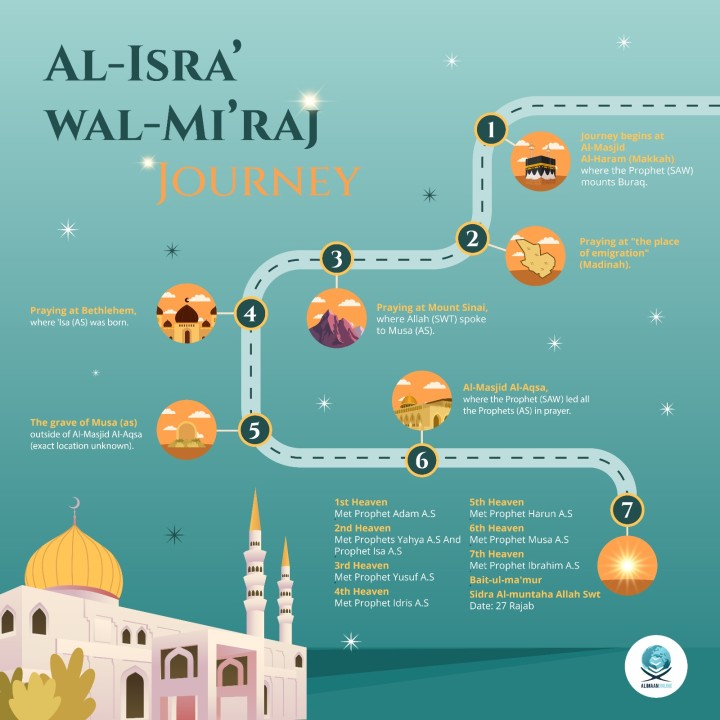Al-Isra wal Mi’raj took place during a time when Prophet Muhammad (PBUH) was facing intense hardship and pain. The Quraysh, who were his tribe and his family, constantly ridiculed, humiliated and oppressed Prophet Muhammad (PBUH) and his followers.
Moreover, Prophet Muhammad (PBUH) had just faced the Year of Sorrow (’Aam al-Huzn), during which he (SAW) lost his beloved wife Khadijah (RA), and his uncle Abu Talib, who was his protector and ally.
About Al-Isra wal Mi’raj
It is being mentioned in surah Al-Isra.
The first evidence is from Quranic scripture Chapter 17 verse one ( Surah Al-Isra) :
سُبۡحٰنَ الَّذِىۡۤ اَسۡرٰى بِعَبۡدِهٖ لَيۡلاً مِّنَ الۡمَسۡجِدِ الۡحَـرَامِ اِلَى الۡمَسۡجِدِ الۡاَقۡصَا الَّذِىۡ بٰرَكۡنَا حَوۡلَهٗ لِنُرِيَهٗ مِنۡ اٰيٰتِنَا ؕ اِنَّهٗ هُوَ السَّمِيۡعُ الۡبَصِيۡرُ
Journey of Al-Isra wal Mi’raj
Journey of Al-Isra’:
Isra means “ nocturnal Journey”. Derived from the Arabic root words سرى ( sara), it means “ travel at night”. Whereas in this particular context, it refers to the night journey or transportation of Prophet Muhammad peace be upon him from his hometown or place of birth Mecca to the furthest mosque of Aqsa in Jerusalem. This was the first part or phase of the complete nightly ascension.
When the Prophet (saw) was sleeping in the house of Umm Hani (ra) in Makkah he said, ‘the roof of my house was opened and the Angel Jibril [as] descended’ (Bukhari). Scholars reconciling between various narrations, say the Prophet (saw) was then taken to the Hijr, the semi-circular wall of the Ka‘bah, where the Prophet (saw) said that Jibril (as), ‘opened my chest, and washed it with Zamzam water.
Then he brought a golden tray full of wisdom and faith, and having poured its contents into my chest, he closed it’. [Bukhari]
The Prophet (saw) continued, ‘I was then brought a white beast which is called al-Buraq [from the Arabic word barq, meaning lightning], bigger than a donkey and smaller than a mule. Its stride was as long as the eye could reach’. [Muslim]
It is narrated by Anas (ra) that Buraq was, ‘saddled and reined, but he shied from him (saw). So Jibril [as] said to him, “Is it from Muhammad [saw] that you do this? For nobody has ridden you who is more honourable to Allah than him!” He said, “Then he started sweating profusely”’. [Tirmidhi]
At several points along the journey, Jibra’eel (as) stopped Buraq and told the Prophet (saw), ‘Dismount and pray’. The first stop was at ‘the place of emigration’ i.e. Madinah – and soon after this night the Prophet (saw) would meet the Ansar and migrate to Madinah.
The second stop was at Mount Sinai, where Allah (swt) revealed the Torah to Musa (as). The third stop was at Bethlehem, where ’Isa (as) was born.
The fourth stop was the grave of Musa (as), ‘I happened to pass by Musa [as] on the night of my Night journey by the red sandhill whilst he was standing praying in his grave’ (Muslim). We know that his grave is located, ‘a stone’s throw’ away from the holy land of the Blessed Masjid Al-Aqsa (Bukhari).
This incident clearly shows us an example of what the Messenger of Allah (saw) said about Prophets (as) after they pass away that, ‘The Prophets are alive in their graves praying’ (Abu Ya‘la).
Finally, the Messenger of Allah (saw) arrived in the holy city of Al-Quds (Jerusalem) and he said, ’When we reached Bait al-Maqdis [literally ‘the holy house’ another name for the Blessed Masjid Al-Aqsa] Jibril (as) pointed with his finger causing a crack in the rock, and he tied the Buraq to it [at the western wall of the noble sanctuary]’ (Tirmidhi).
Waiting inside were all 124,000 Prophets (as). Jibra’eel (as) led the Prophet (saw) to the front, and he (saw) led them all in prayer in this blessed space.
Journey of AL Mi’raj
Al-Mi’raj:
Miraj is an Arabic word meaning “ladder, to elevate, or to ascend”. In Islamic literature, it is used for the night journey of Al Mi’raj Prophet Muhammad when he was miraculously taken to the presence of Allah The Almighty in Heaven.
According to the Islamic faith, it is one of the major miracles of the Prophet ﷺ. This also refers to the second phase and the one which was most contended by the Arab polytheists of that time.
Nevertheless, there is sufficient evidence in the Islamic scripture which is the Quran and the prophetic narrations commonly referred to as Ahadith as blatant proof of this event that it actually took place and was not based on mere whims or a probable dream interpretation of the messenger of Allah.
The dominant opinion is that the Prophet (saw) alongside Jibril (as) then proceeded to the Noble Rock (as-Sakhrah al-Musharrafah) that is currently housed by the holy Dome of the Rock Masjid at the centre of the noble sanctuary (al-Haram ash-Sharif) of the Blessed Masjid Al-Aqsa.
The First Sky
Allah ascended the Prophet (saw) from the Dome of the Rock through the skies, where he not only saw many miraculous sights and numerous angels, he also met the past Prophets (as). Along the way, he (saw) was greeted with excitement and delight, as his arrival had been much-anticipated.
The Messenger of Allah (saw) said: ’Then he ascended with us to the heaven [first layer of the sky and end of the known universe]. Jibril [as] then asked the (gate of heaven) to be opened (by knocking on one of its doors). [Bukhari]
It was said, “Who are you?” He said, “Jibril [as]“.
It was said, “And who is with you?” He said, “Muhammad [saw]“.
It was said, “Has he been sent for?” He said, “He has indeed been sent for”.
And it (the door of the heaven) was opened for us and suddenly I was with (the Prophet) Adam [as]. Then he welcomed me and supplicated for good for me’. [Muslim]
The Second to Sixth Sky
Then the Prophet (saw) continued to ascend the layers of sky with Jibril (as). Again, permission was sought to enter, and the angelic guards were delighted and welcomed the Messenger of Allah (saw).
At the second sky, he met the maternal cousins, the Prophets Isa (as) and Yahya (as).
At the third sky, the Prophet (saw) met the Prophet Yusuf (as) whom he described as having ‘been given half of (world) beauty’ [Muslim]. The Messenger of Allah (saw) had himself been blessed with all beauty, ma sha’ Allah!
At the fourth sky, the Prophet (saw) met the Prophet Idris (as) whose soul was taken there, and he is praised in the Qur’an: ‘We raised him to a lofty position’. [The Noble Qur’an, 19:57]
At the fifth sky, he met the Prophet Harun (as); and in the sixth sky, he met Prophet Harun’s younger brother, the Prophet Musa (as).
The Seventh Sky
At the seventh sky, the Prophet (saw) met his greatest ancestor, the Prophet Ibrahim (as) who was ‘reclining his back against al-Bait al-Ma‘mur. And there enter into it seventy thousand angels every day, never to return to it (again)’. [Muslim]
(Bait al-Ma’mur literally means ‘the much-visited House’. It is the heavenly Ka‘bah directly above the one on earth).
Sidrah al-Muntaha
It is a huge Sidr tree as well as the end of the seventh heaven. According to Islamic beliefs, this is the boundary no one ever passed except Prophet Muhammad (PBUH) along with angel Jibreel. This is where Allah told Prophet Muhammad (PBUH) that Muslim believers were to enrol in prayers 50 times a day.
The Prophet accepted the offer but as he was going back to the earth, he met Prophet Moses who advised that 50 prayers were too much for a day. Prophet Muhammad (PBUH) went back to Allah and requested to reduce 50 prayers as it was too much. Allah reduced 5 prayers and made it 45 prayers a day.
But according to Prophet Moses, it was still too much. Prophet Muhammad (PBUH) took nine trips between Moses and Almighty Allah and after that, it was finally reduced to 5 times prayers a day.
Prophet Moses continued to ask for the reduction in numbers, but Prophet Muhammad (PBUH) said that he was too guilt-ridden. Moreover, he is grateful for 5 prayers a day.
It was here that Allah gave this Ummah the gift of compulsory Salah, a daily source of strength to Muslims because it gives us the opportunity to communicate with Allah and draw closer to Him.
Finally, the Prophet (saw) was taken back down to the Blessed Masjid Al-Aqsa and returned to Makkah on the Buraq.
You can read learning the Holy Qur’an
As he was transported home, he saw various caravans heading towards Makkah, which he would later describe to the Quraish as proof that he really had made this miraculous journey. Allah even displayed Bait al-Maqdis to the Prophet (saw), while the Quraish were cross-examining him in the Hijr of the Ka‘bah [Bukhari].
The entire journey of AL MI’raj had taken place in a small portion of a night, and there were many who would mock the Prophet (saw) for making such a claim.
On the night of 27th Rajab*, as well as offering naffal prayers, giving sadaqah and increasing other forms of worship, It’s important to reflect on Al-Isra wal Mi’raj and draw lessons from the blessed event which may greatly help us.
For those who may be experiencing a difficult period of time in their lives, Al-Isra wal Mi’raj is a reminder of what Allah tells us in the Qur’an- “For indeed, with hardship [will be] ease. Indeed, with hardship [will be] ease.“ Quran, 94:5-8.

